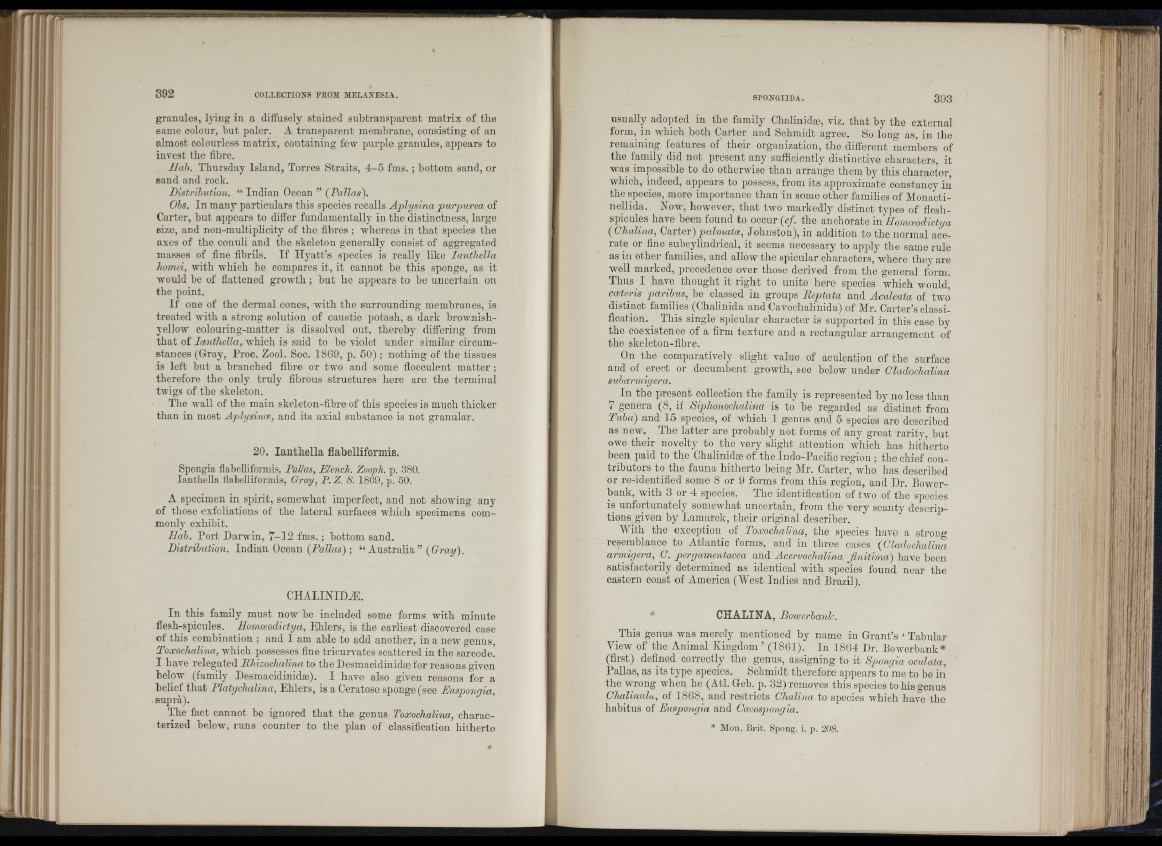
w
I -
1
îil ^ ? !
granules, lying in a diffusely stained suhtransparent matrix of the
same colour, hut paler. A transparent membrane, consisting of an
almost colourless matrix, containing few purple granules, appears to
invest the fibre.
Hah. Thursday Island, Torres Straits, 4 -5 fm s.; bottom sand, or
sand and rock.
Distrihution. “ Indian Ocean ” (Pallas).
Ohs. In many particulars this species recalls Aplysina purpurea of
Carter, hnt appears to differ fundamentally in the distinctness, large
size, and non-mnltiplicity of the fibres ; whereas in th at species the
axes of the conuli and the skeleton generally consist of aggregated
masses of fine fibrils. If H y a tt’s species is really like lanthella
homei, with which he compares it, it cannot he this sponge, as it
would he of flattened growth ; hut he appears to he uncertain on
the point.
I f one of the dermal cones, with the surrounding membranes, is
treated with a strong solution of caustic potash, a dark brownish-
yellow colouring-matter is dissolved out, thereby differing from
th at of lanthella, which is said to be violet under similar circumstances
(Gray, Proc. Zool. Soc. 1869, p. 50 ); nothing of the tissues
is left hut a branched fibre or two and some flocculent m a tte r;
therefore the only truly fibrous structures here are the terminal
twigs of the skeleton.
The wall of the main skeleton-fibre of this species is much thicker
than in most Aplysina, aud its axial substance is not granular.
20. lanthella flahelliformis.
Spongia flahelliformis, Pallas, Elench. Zooph. p. 380.
lanthella flahelliformis, Gray, P. Z. S. 1869, p. 50.
A specimen in spirit, somewhat imperfect, and not showing any
of those exfoliations of the lateral surfaces which specimens commonly
exhibit.
Hah. Port Darwin, 7-12 fm s.; bottom sand.
Distrihution. Indian Ocean (Pallas); “ Australia ” (Gray).
CHALINIDÆ.
In this family must now he included some forms with minute
flesh-spicules. Homceodictya, Ehlers, is the earliest discovered case
of this combination ; and 1 am able to add another, in a new genus,
Toxochalina, which possesses fine tricurvates scattered in the sarcode]
I have relegated EMzochahna to the Desmacidinidæ for reasons given
below (family Desmacidinidse). I have also given reasons for a
belief th at Platychalina, Ehlers, is a Ceratose sponge (see Euspongia,
supra).
The fact cannot bo ignored th at the genus Toxochalina, characterized
below, runs counter to the plan of classification hitherto
usually adopted in the family Chalinidæ, viz. th at by the external
form, in which both Carter and Schmidt agree. So long as, iu the
remaining features of their organization, the different members of
the family did not present any sufficiently distinctive characters, it
was impossible to do otherwise than arrange them by this character
which, indeed, appears to possess, from its approximate constancy in
the species, more importance than in some other families of Monactinellida.
Now, however, th at two markedly distinct types of flesh-
spicules have been found to occur (cf. the anchorate in Uomoeodictya
(Chalina, Carier)palmata, Johnston), in addition to the normal acerate
or fine subcylindrical, it seems necessary to apply the same rule
as in other families, and allow the spicular characters, where they are
well marked, precedence over those derived from the general form.
Thus I have thought it right to unite here species which would,
coeteris parihus, be classed in groups lieptata and Aculeata of two
distinct families (Chalinida and Cavochalinida) of Mr. Carter’s classification.
^ This single spicular character is supported in this case by
the coexistence of a firm texture and a rectangular arrangement of
the skeleton-fibre.
On the comparatively slight value of aculeation of the surface
and of erect or decumbent growth, see below under Cladochalina
subarniigera.
In the present collection the family is represented by no less than
7 genera (8, if Siphonochalina is to he regarded as distinct from
Tuha) and 15 species, of which 1 genus and 5 sjiecios are described
as new. The latter are probably not forms of any great rarity, hut
owe their novelty to the very slight attention which has hitherto
been paid to the Chalinidæ of the Indo-Pacific region ; the chief contributors
to the fauna hitherto being Mr. Carter, who has described
or re-identified some 8 or 9 forms from this region, and Dr. Bowerbank,
with 3 or 4 species. The identification of two of the species
is unfortunately somewhat uncertain, from the very scanty descriptions
given by Lamarck, their original descriher.
With the exception of Toxochalina, the species have a strong
resemblance to Atlantic forms, and in three cases (Cladochalina
armigera, G. pergamentacea and Acervoclialina finitima ) have been
satisfactorily determined as identical with species found near the
eastern coast of America (West Indies and Brazil).
■ (■
CHALINA, Boiverhank.
This genus was merely mentioned by name in Grant’s ‘ Tabular
View of the Animal Kingdom ’ (1861). In 1864 Dr. Bowerbank*
(first) defined correctly the genus, assigning to it Spongia oculata,
Pallas, as its type species. Schmidt therefore appears to me to be in
the wrong when he (Atl. Geb. p. 32) removes this species to his genus
Chalinulu, of 1868, and restricts Chalina to species which have the
habitus of Euspongia and Cacospongia.
A,
■ '